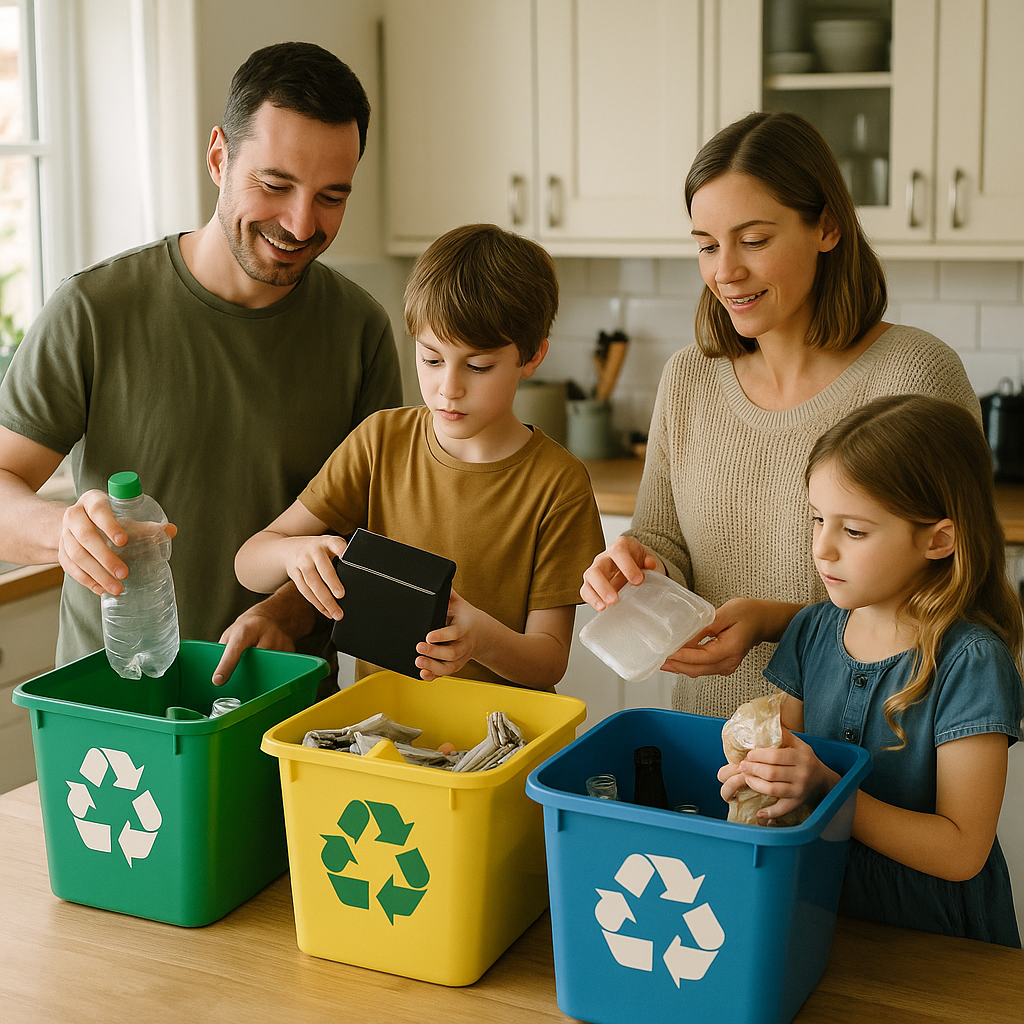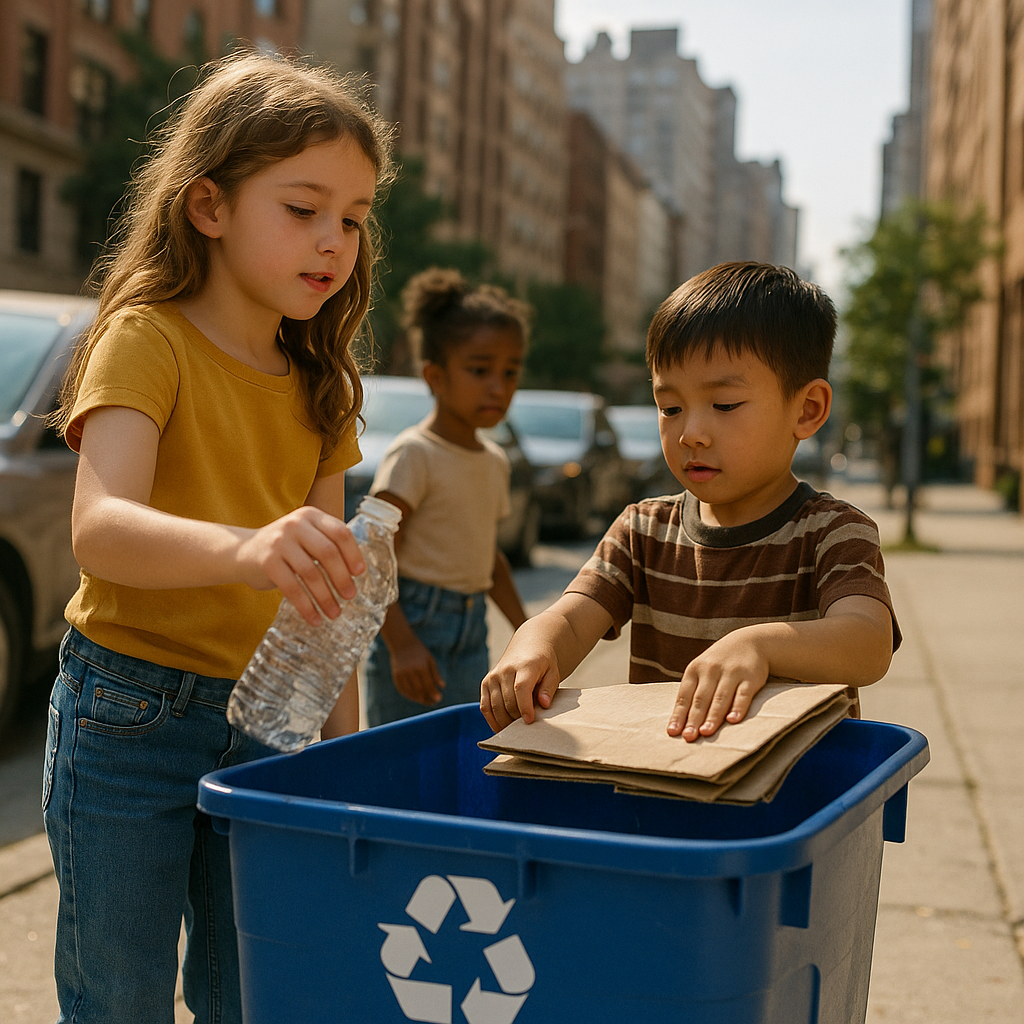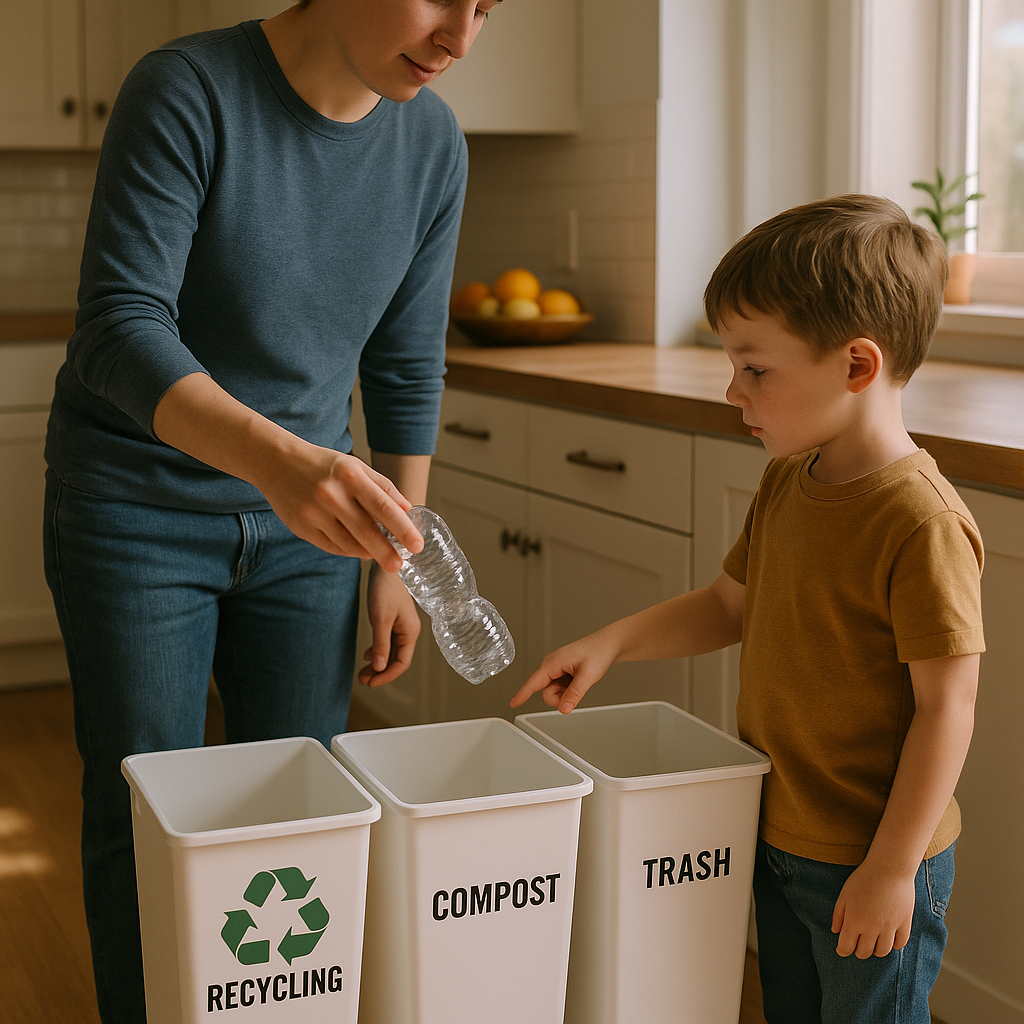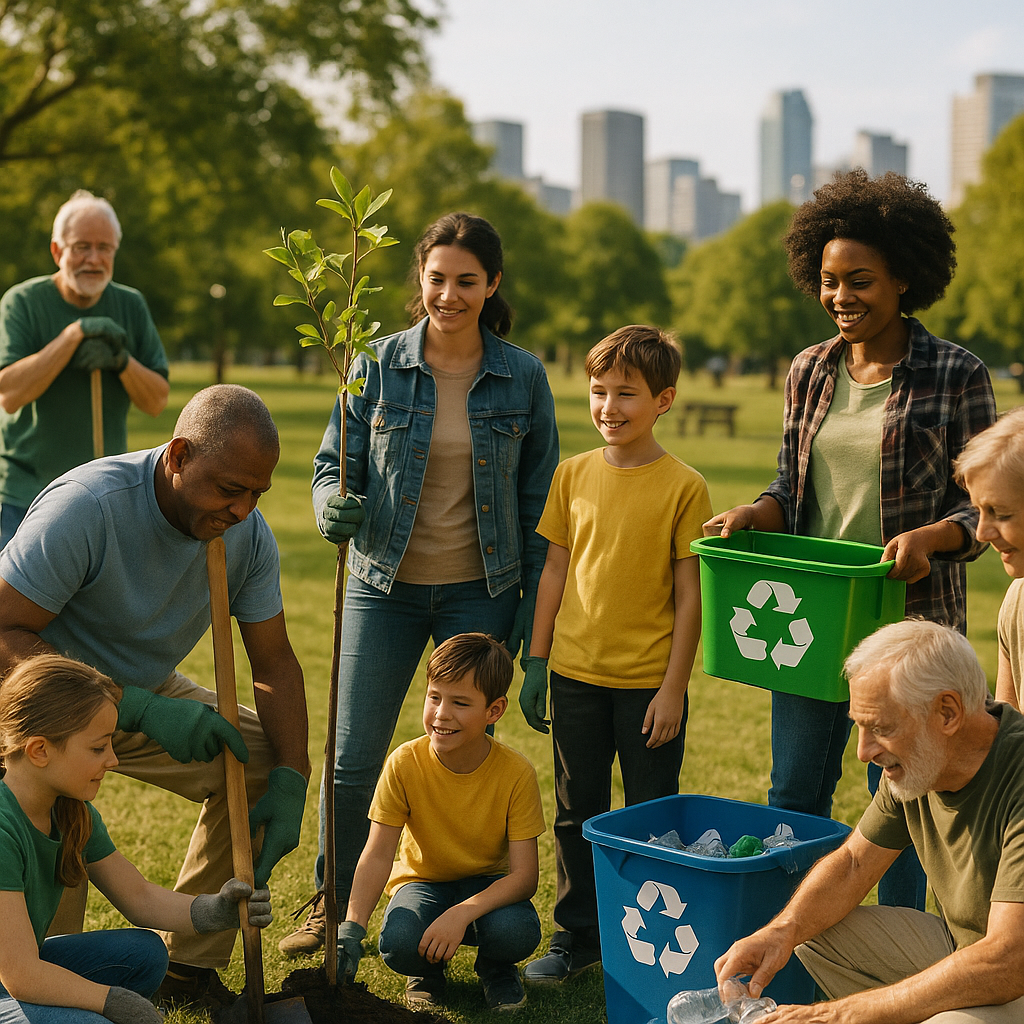5901 Botham Jean Blvd, Dallas, TX 75215
Reduce, Reuse, Recycle: Practical Tips for Sustainable Waste Management”
August 29, 2025The ‘Reuse, Reduce, Recycle’ concept represents a comprehensive waste management framework designed to minimize our environmental footprint. This approach provides a strategic hierarchy for making environmentally conscious decisions about consuming and disposing of materials. The order of the ‘Three Rs’ is significant: reduce, reuse, then recycle.
Reducing involves minimizing the waste generated initially, which includes making thoughtful purchasing decisions, avoiding unnecessary consumption, and choosing products with minimal packaging. Reusing focuses on finding new purposes for items instead of discarding them after a single use. This can include repurposing containers, donating used clothing, or repairing broken items rather than replacing them. Recycling, while often the most recognized component, is the final option in the hierarchy—transforming waste materials into new products through various processing methods.
The Three Rs together serve as a practical guide for waste management decision-making, offering solutions that keep valuable resources in circulation and significantly reduce the waste sent to landfills. By implementing these principles in daily life, we help conserve natural resources, reduce greenhouse gas emissions, and preserve our environment for future generations.
How Can We Reduce Waste?

Reducing waste begins with mindful consumption. Prevention, rather than recycling alone, is the most effective strategy for minimizing what ends up in landfills. The decisions we make before purchasing have the greatest impact on our waste footprint.
Mindful consumption involves being purposeful about what we buy. Before making a purchase, consider if the item truly serves a need or purpose. This thoughtful approach helps break the cycle of accumulating items that quickly become waste.
Buy Only What You Need
Overconsumption is a leading cause of waste generation. Creating a shopping list before heading to the store helps you focus on essentials and avoid impulse buys, which reduces waste and saves money.
For non-essentials like clothing or home décor, choose timeless, quality items that offer longevity rather than following short-lived trends. Thoughtful purchasing has the dual benefit of waste reduction and cost savings.
Choose Products with Minimal Packaging
Packaging waste accounts for nearly 141 million tonnes of plastic waste globally each year. When shopping, select products with less packaging or those with recyclable or compostable materials.
Buying in bulk significantly reduces packaging waste. Items like grains, nuts, and cleaning supplies purchased from bulk bins eliminate the need for individual packaging. Many stores now allow customers to bring their own containers, further reducing waste.
Switch to Reusable Alternatives
Disposable items may seem convenient, but their environmental impact is substantial. Reusable products like water bottles, shopping bags, and stainless-steel straws offer practical alternatives that reduce waste while being more durable and cost-effective.
Investing in high-quality reusable products means fewer replacements over time. Simple swaps like using cloth napkins instead of paper ones or silicone baking mats instead of parchment paper prevent thousands of disposable items from entering landfills.
In the kitchen, replacing plastic wrap with beeswax wraps or silicone food covers eliminates a significant source of waste. These alternatives often outperform disposable counterparts, keeping food fresher longer.
Embrace Digital Alternatives
Paper waste remains a significant environmental challenge despite digital technology. Opting for electronic bills, statements, and receipts reduces paper consumption while making document organization more efficient.
Digital subscriptions for news, magazines, and books eliminate the need for printing and shipping physical copies. Many services offer features like note-taking and highlighting, making the digital experience as functional as print.
For unavoidable paper use, choose recycled paper products and print on both sides when possible. Setting printers to default to double-sided printing can halve paper use without extra effort.
Practice Food Waste Reduction
Food waste is a major environmental issue, with significant resources used to grow, process, and transport food that often goes uneaten. Meal planning ensures food is used efficiently before spoiling.
Proper food storage extends shelf life and prevents waste. Techniques like freezing extras, understanding expiration versus “best by” dates, and repurposing leftovers into new meals all contribute to reducing food waste.
Composting food scraps completes the cycle by turning unavoidable food waste into nutrient-rich soil amendment. Even apartment dwellers can compost with small-scale systems designed for limited spaces.
Repair Instead of Replace
Our culture often encourages replacing items at the first sign of wear or malfunction. Learning basic repair skills or finding local repair services extends the life of clothing, furniture, electronics, and appliances.
Many communities host repair cafés where volunteers help fix items that would otherwise be discarded. Supporting right-to-repair legislation ensures companies provide repair information and parts for their products, making repairs more accessible.
| Item | Single-Use Version | Reusable Alternative |
| Bags | Plastic bags | Cotton bags |
| Bottles | Plastic bottles | Stainless steel bottles |
| Straws | Plastic straws | Bamboo straws |
| Wraps | Plastic wrap | Beeswax wraps |
Shifting toward waste reduction requires changing habits and perspectives. Although it might seem challenging at first, these practices quickly become second nature. Starting with just one or two changes can build momentum toward a less wasteful lifestyle that benefits our environment and our wallets.
What Are Effective Ways to Reuse Items?

Reusing items is a practical way to reduce waste and extend product lifecycles. Before discarding something, consider its potential for a second life. Creative reuse not only keeps items out of landfills but also saves money and resources that would otherwise go into manufacturing new products.
Household Repurposing Projects
Many everyday items can be transformed with minimal effort. Glass jars from food products make excellent storage containers for pantry staples, craft supplies, or vases for small floral arrangements. Plastic bottles can be cut to create mini greenhouses for seedlings, protecting young plants while allowing you to monitor their growth.
Old furniture often has untapped potential. Wooden dressers can be repurposed into kitchen islands, providing extra counter space and storage. Outdated dining chairs can be refreshed with paint and new upholstery, or even converted into a bench for your entryway or garden.
Textile Reuse
Textiles are versatile for reuse. Old bed sheets that are no longer suitable for sleeping can serve as drop cloths for painting projects or picnic blankets, or be cut into reusable grocery bags. Well-worn t-shirts make excellent cleaning rags, while fabric scraps can be sewn into patchwork quilts, pillow covers, or decorative items.
Even single socks that have lost their mates can find new purposes as dust mitts, storage for fragile items, or when filled with rice, as heating pads or draft blockers.
Creative Container Reuse
Containers offer abundant reuse opportunities. Coffee cans and popcorn tins can be cleaned, painted, and transformed into planters for indoor or outdoor use. Egg cartons are perfect for starting seedlings before transferring them to your garden.
For a decorative touch, chipped dishes and plates can be broken into pieces and arranged into mosaic patterns on stepping stones, tabletops, or planters. Simply mix concrete in a suitable mold, arrange your design, and allow it to dry for a personalized garden accent or home decor item.
Donation and Community Sharing
Sometimes the most effective way to reuse an item is to pass it along to someone who needs it. Clothing, furniture, books, and household goods in good condition can be donated to local charities. Many organizations will even pick up larger items from your home.
Community sharing platforms and buy-nothing groups allow you to give unwanted items directly to neighbors who can use them, building community connections while extending the useful life of products.
Upcycling for Home Decor
Upcycling transforms discarded objects into items of greater value or quality. Old wooden ladders can be mounted horizontally on walls as unique bookshelves or towel racks. Vintage suitcases can become stylish side tables, while old doors can serve as distinctive headboards or dining tables.
Even simple items like tin cans can be cleaned, decorated, and grouped together as organizers for office supplies or kitchen utensils. The possibilities are limited only by your imagination and willingness to experiment.
| Item | Reuse Ideas |
| Glass Jars | Storage for pantry staples, vases, freezing soups, fermenting foods |
| Plastic Bottles | Rainwater catcher, cooking tool, planters |
| Newspapers | Firestarter, shoe deodorizer, wrapping paper |
| Egg Cartons | Seed starters, organizing small items |
| Old Clothing | Cleaning rags, wrapping breakables, pillow covers |
| Styrofoam Containers | Shipping pellets, kickboards, shoe padding |
| Shower Curtains | Drop cloth, windshield cover |
Reuse in the Garden
Gardens offer countless opportunities for creative reuse. Broken terra-cotta pots can be placed upside down to create toad habitats that help control garden pests naturally. Old rakes, with tines pointed outward, make excellent tool organizers when mounted on shed walls.
Plastic beverage containers can be modified into self-watering planters or bird feeders. Even an old toy wagon can be repurposed as a mobile herb garden that can be easily moved to follow the sun or brought indoors during cold weather.
By viewing objects through the lens of potential rather than obsolescence, we can significantly reduce waste while discovering creative solutions to everyday needs. Reuse represents a critical component of sustainable living, requiring nothing more than a willingness to pause before discarding and consider: What else could this become?
Why is Recycling Important?

Recycling is a powerful tool for environmental protection and resource management. This simple act of turning used materials into new products creates a myriad of benefits beyond just keeping items out of landfills.
Recycling materials like paper, plastic, glass, and metal directly conserves natural resources that would otherwise be extracted from the earth. The impact is substantial. For example, recycling one ton of paper saves about 17 trees, 7,000 gallons of water, and 463 gallons of oil. The savings are even more impressive with metals; recycling one ton of aluminum can save up to 8 tons of bauxite ore and use 95% less energy than producing new aluminum.
The energy savings from recycling result in significant reductions in greenhouse gas emissions. Manufacturing products from recycled materials typically requires far less energy than making them from raw sources. This efficiency means fewer carbon emissions, helping mitigate climate change impacts.
Pollution reduction is another critical benefit. By recycling rather than discarding, we prevent potentially harmful substances from entering our soil, water, and air. The Environmental Protection Agency notes that recycling reduces water pollution by decreasing the need for extracting new materials, which can lead to runoff and other contamination.
Beyond environmental advantages, recycling delivers substantial economic benefits. The recycling industry creates jobs across various sectors, from collection and processing to manufacturing new products. Research shows recycling can generate up to ten times more jobs per ton of material than landfilling or incineration. In the United States alone, recycling supports hundreds of thousands of jobs and contributes billions to the national economy.
For businesses and municipalities, recycling makes financial sense. Effective recycling programs often lead to cost savings through reduced waste disposal fees. These avoided costs can be significant, especially where landfill fees are high. Many businesses find that recycling helps reduce overall waste management costs by using smaller dumpsters and decreasing collection frequency.
Recycling also stimulates economic development by creating new markets and industries focused on utilizing recycled materials. These markets continue to expand as demand for sustainable products grows, driving innovation and investment in recycling technologies.
| Material | Energy Savings (%) | Job Creation (Jobs/10,000 tons) | Notable Benefits |
|---|---|---|---|
| Aluminum | 95% | 36 | Saves enough energy to power a TV for three hours |
| Steel | 60-74% | 36 | Uses 40% less water, generates 97% less mining waste |
| Paper | 40% | 36 | Each ton saves about 17 trees |
| Plastic | 70% | 36 | Significantly conserves petroleum resources |
The circular economy model that recycling supports offers a more sustainable economic system than the traditional “take-make-dispose” approach. By keeping materials in use longer, we maximize their value and minimize waste, offering a path to economic growth without relying on extracting finite resources.
Considering both the environmental and economic benefits, the importance of recycling is clear. Each decision to recycle supports resource conservation, pollution reduction, energy savings, and economic development, making it an essential practice for building a more sustainable future.
How Can We Improve Our Recycling Habits?

Effective recycling starts with understanding your local guidelines. Each municipality has different rules for what can and cannot be recycled. Visit your city’s recycling website or contact your waste management provider to learn the specific requirements for your area. Many communities even offer mobile apps that provide real-time information about acceptable materials.
Proper sorting is fundamental to successful recycling. Set up a clearly labeled system in your home with separate containers for different materials. Place bins in convenient locations throughout your house to make recycling accessible. The kitchen usually serves as the primary recycling station, but smaller containers in bathrooms and home offices can capture recyclables that might otherwise end up in the trash.
Focus on Quality Over Quantity
One of the biggest challenges in recycling is contamination. Make “clean, empty, and dry” your mantra when preparing items for recycling. Food residue can contaminate entire loads of otherwise recyclable materials. Rinse containers thoroughly and ensure they’re completely dry before adding them to your bin.
Stop “wishcycling” — placing non-recyclable items in the recycling bin. This well-intentioned habit actually causes more harm than good. When in doubt, throw it out. Items smaller than a credit card typically can’t be processed by recycling equipment, so keep straws, bottle caps, and small pieces of paper out of your recycling bin.
Flattening cardboard boxes before recycling saves space and improves processing efficiency. Remove any non-recyclable elements like plastic windows from envelopes or foam inserts from packaging. Never bag your recyclables — place them loose in your bin instead. Plastic bags are major contaminants that can jam sorting equipment.
Make Smarter Purchasing Decisions
Recycling begins at the store. Choose products with minimal or recyclable packaging. Look for items in containers made from commonly recycled materials like aluminum, glass, or plastics #1 and #2. Consider durability and reusability when making purchases. Products designed to be used multiple times create less waste than single-use alternatives.
Pay attention to the Australasian Recycling Label (ARL) or similar packaging labels in your region. These provide clear instructions about which parts of packaging can be recycled through curbside collection and which require special handling. This information helps you make more environmentally responsible purchasing decisions.
Avoid products with combined materials that can’t be separated for recycling. Items like plastic-coated paper cups, laminated paper, and bubble-wrap envelopes usually end up in landfills because their components can’t be processed together. When possible, choose single-material alternatives.
| Item | Recyclability | Considerations |
|---|---|---|
| Paper and Cardboard | Recyclable | Remove food residues and flatten boxes |
| Glass | Recyclable | Avoid mixing broken glass with recyclables |
| Plastics | Depends on type | Check local guidelines for specific plastics |
| Aluminum Cans | Recyclable | Do not crush if single-stream recycling |
| Electronics | Recyclable at special centers | Many stores offer recycling programs |
| Textiles | Recyclable or Donatable | Repurpose when possible |
| Batteries | Recyclable | Requires special handling |
Engage Your Community
Individual efforts matter, but community involvement amplifies impact. Join or organize neighborhood clean-up events. Participate in local recycling education programs or start a recycling club to share information and strategies with neighbors. Working together creates a culture of sustainability that extends beyond waste management.
Support local recycling initiatives by participating in specialized collection events for items like electronics, batteries, or hazardous materials. These programs ensure proper handling of items that shouldn’t go in regular recycling bins. Many retailers also offer take-back programs for specific products.
Share your knowledge with others. Many people want to recycle correctly but lack information. Simple conversations about proper recycling practices can significantly reduce contamination rates. Consider posting recycling guidelines in common areas if you live in a multi-family dwelling.
Establish Consistent Routines
Create a regular schedule for emptying indoor recycling bins and taking materials to collection points. Consistency prevents overflow and maintains organization. In households with multiple members, rotate responsibilities to build recycling habits across the family.
Track your progress by monitoring how much waste you divert from landfills. This provides motivation and helps identify areas for improvement. Some communities offer waste audits or resources to help residents assess their recycling effectiveness.
Remember that reducing waste is even better than recycling it. Before recycling, consider whether items can be reused, repurposed, or avoided altogether. The most effective recycling habit is consuming less in the first place.
Conclusion: Embracing the Reuse, Reduce, Recycle Lifestyle

Embracing a ‘Reuse, Reduce, Recycle’ lifestyle is one of the most impactful ways individuals can contribute to environmental conservation. Throughout this article, we’ve explored practical strategies to transform our daily habits into sustainable actions. By prioritizing waste reduction, creatively reusing items, and practicing proper recycling, we each play a vital role in protecting our planet’s limited resources and minimizing pollution that harms ecosystems worldwide.
The journey toward sustainability doesn’t require perfection. Small, consistent changes in shopping, consumption, and disposal collectively create significant positive impacts. Whether switching to reusable shopping bags, composting food scraps, or being more mindful about purchases, these actions support a circular economy where materials maintain their value rather than becoming waste. For assistance with recycling and waste management needs, contact Okon Recycling at 214-717-4083.
